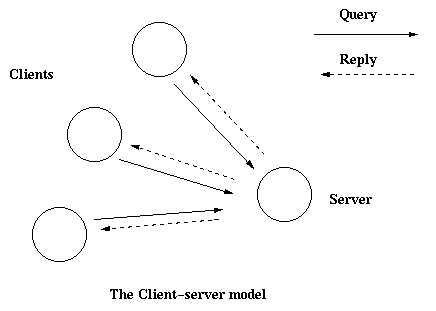Gen_Server行为¶
本章要与 gen_server(3) 结合起来阅读,它详细描述了所有的接口函数和回调函数。
例子¶
在概述中,已经有一个用普通Erlang方式写的简单服务器。这个服务器可以用 gen_server 进行重写,结果产生这个回调模块:
-module(ch3).
-behaviour(gen_server).
-export([start_link/0]).
-export([alloc/0, free/1]).
-export([init/1, handle_call/3, handle_cast/2]).
start_link() ->
gen_server:start_link({local, ch3}, ch3, [], []).
alloc() ->
gen_server:call(ch3, alloc).
free(Ch) ->
gen_server:cast(ch3, {free, Ch}).
init(_Args) ->
{ok, channels()}.
handle_call(alloc, _From, Chs) ->
{Ch, Chs2} = alloc(Chs),
{reply, Ch, Chs2}.
handle_cast({free, Ch}, Chs) ->
Chs2 = free(Ch, Chs),
{noreply, Chs2}.
在下一节中会解释这段代码。
启动一个Gen_Server¶
在前一节中的代码,可以通过 ch3:start_link() 来启动这个gen_server:
start_link() ->
gen_server:start_link({local, ch3}, ch3, [], []) => {ok, Pid}
start_link 调用了函数 gen_server:start_link/4 。这个函数产生了一个新进程一个gen_server并联接到其上。
- 第一个参数 {local, ch3} 指定了名称。在这种情况下,gen_srever将在本地被注册为 ch3 。 如果忽略名称,那么这个gen_server就不会被注册了,这时就必须使用其pid。名称也可以以 {global, Name} 的形式给出,这种情况下gen_server则会使用 global:register_name/2 来进行注册。
- 第二个参数, ch3, 则是回调模块的名字,也就是回调函数所放的那个模块。 在这里,接口函数( start_link, alloc 和 free )和回调函数(init, handle_call 和 handle_cast)。一般来说这是好的编程实践,将代表同一个进程的代码包含在同一个模块中。
- 第三个参数,[], 这个值将被原封不动传递给回调函数 init。在这里,init无须任何输入数据将忽略这个参数。
- 第四个参数,[],是参数的列表。具体的参数请查看 gen_server(3) 。
在注册名称成功后,新的gen_server进程会调用回调函数 ch3:init([]).。init返回 {ok, State} ,其中 State 是gen_server的内部状态。在这里,状态就是可用的频道。
init(_Args) ->
{ok, channels()}.
注意 gen_server:start_link 是同步的。只有等到gen_server被完全初始化并准备接受请求之后才会返回。
如果gen_server是某棵监督树的一部分,即gen_server是由一个督程启动的,那么必须使用 gen_server:start_link 。还有另外一个函数 gen_server:start 用于启动一个独立的gen_server,即不是某棵监督树一部分的一个gen_server。
同步调用——Call¶
同步请求 alloc() 是使用 gen_server:call/2 实现的:
alloc() ->
gen_server:call(ch3, alloc).
ch3 是gen_server的名字,必须和启动时的名字一样。 alloc 是实际的请求。
请求以消息的形式发送给这个gen_server。当收到了请求之后,gen_server调用 handle_call(Request, From, State) ,它应返回一个元组 {reply, Reply, State1}。Reply是需要回馈给客户端的答复,同时 State1 是gen_server的状态的新值。
handle_call(alloc, _From, Chs) ->
{Ch, Chs2} = alloc(Chs),
{reply, Ch, Chs2}.
在这里,应答是分配了的频道 Ch 然后gen_server将等待新的请求,并且现在保持了一个最新的可用频道的列表。
异步请求——Cast¶
异步请求 free(ch) 使用 gen_server:cast/2 实现:
free(Ch) ->
gen_server:cast(ch3, {free, Chr}).
ch3 是gen_server的名称。 {free, Ch} 是实际的请求。
请求被装在一个消息中发给gen_server的 cast ,这调用了 free ,然后返回了 ok 。
当gen_server收到请求之后,它会调用 handle_cast(Request, Stats) ,会返回一个元组 {noreply, State1} 。 State1 是gen_server状态的新值。
handle_cast({free, Ch}, Chs) ->
Chs2 = free(Ch, Chs),
{noreply, Chs2}.
在这里,新的状态便是更新过的可用频道列表 Chs2 。gen_server现在又可以接受新的请求了。
停止¶
在监督树中¶
若gen_server是某个监督树的一部分,则无需停止函数。它的督程会自动终止它。它的具体做法由督程中设置的 关闭策略 定义。
如果在终止之前需要进行一些清理工作,那么关闭策略必须是一个超时值,同时gen_server必须在 init 函数中设置为捕获退出信号。当gen_server被要求关闭时,它就会调用回调函数 terminate(shutdown, State) :
init(Args) ->
...,
process_flag(trap_exit, true),
...,
{ok, State}.
...
terminate(shutdown, State) ->
..code for cleaning up here..
ok.
独立Gen_Server¶
如果gen_server并非某个监督树的一部分,那么可以用一个停止函数,例如:
...
export([stop/0]).
...
stop() ->
gen_server:cast(ch3, stop).
...
handle_cast(stop, State) ->
{stop, normal, State};
handle_cast({free, Ch}, State) ->
....
...
terminate(normal, State) ->
ok.
回调函数处理 stop 请求并返回一个元组 {stop, normal, State1} ,其中 normal 表示这是一个正常的终止, State1 是gen_server状态的新值。这会引发gen_server调用 terminate(normal, State1) 来优雅地终止。
处理其他消息¶
如果要想gen_server还能处理请求之外的消息,必须实现回调函数 handle_info(Info, State) 来处理他们。例如,如果gen_server联结到其它进程(非督程)上并捕获退出信号,那么其它的消息就有退出消息。
handle_info({'EXIT', Pid, Reason}, State) ->
..code to handle exits here..
{noreply, State1}.
